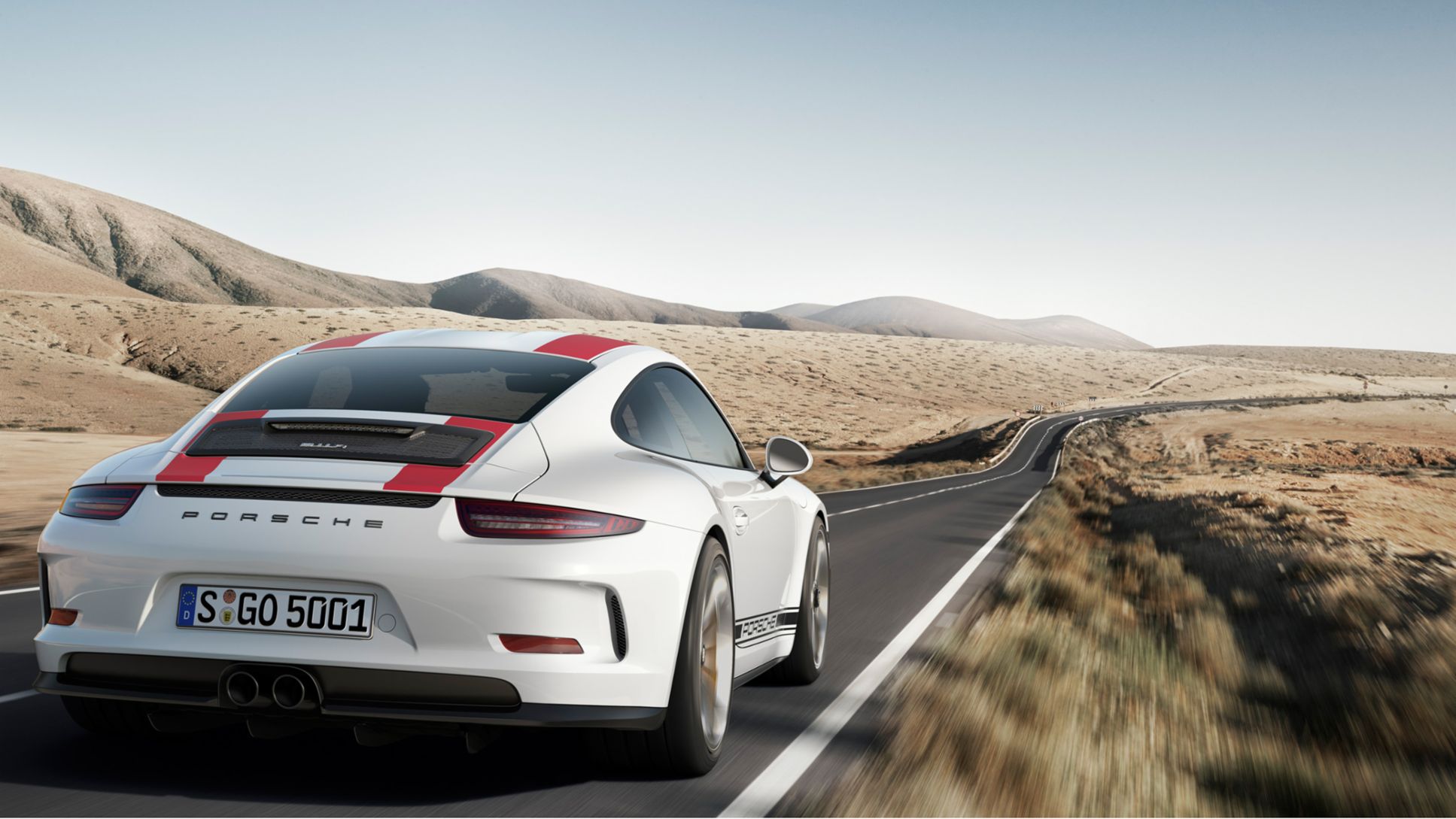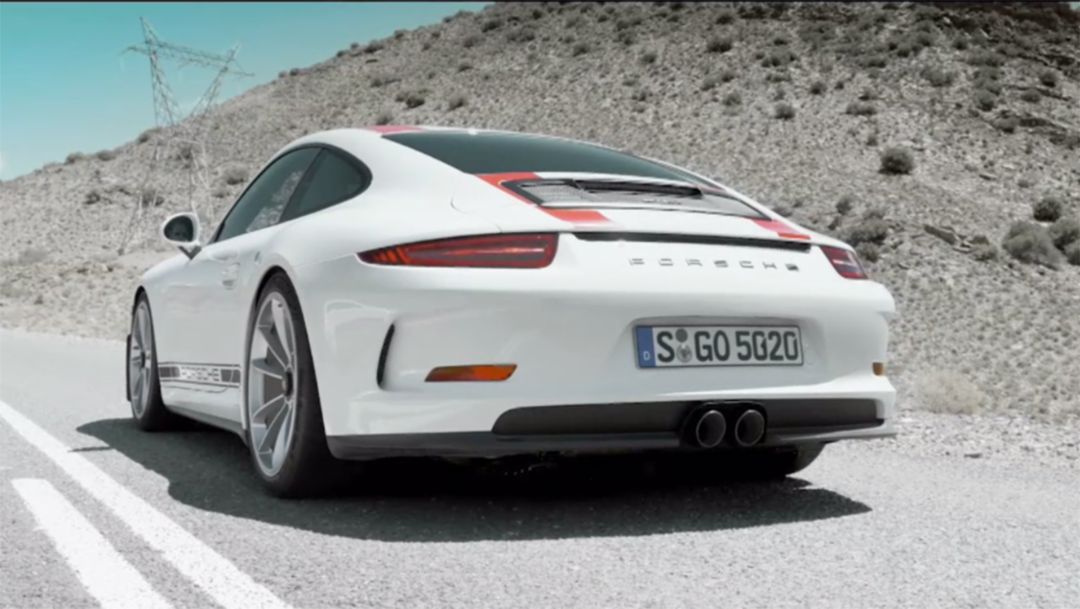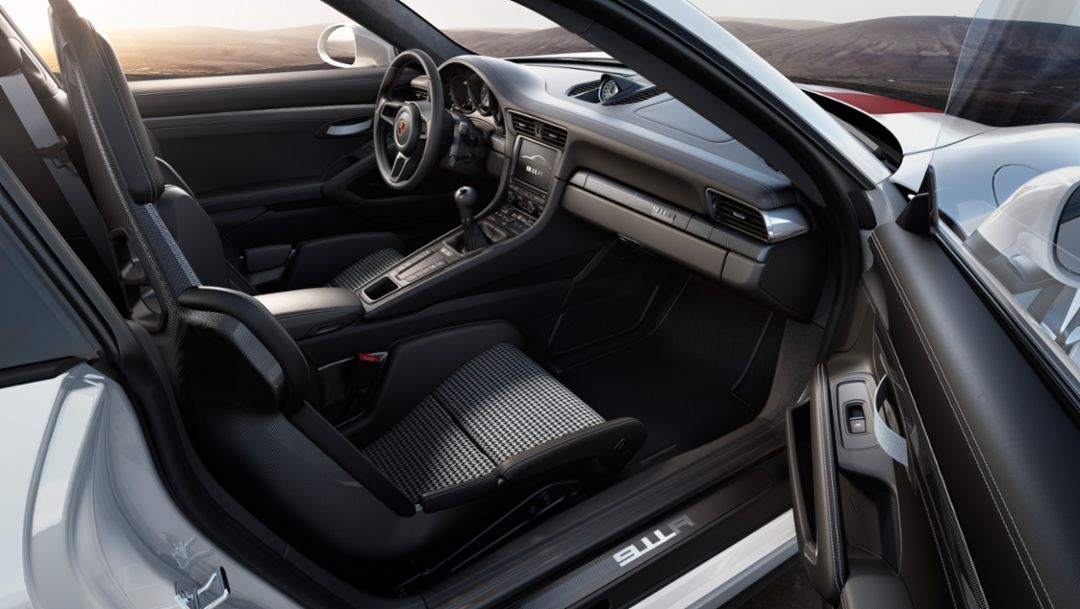Its 368 kW (500 hp, 911 R: Combined fuel consumption 13.3 l/100 km; CO₂ emissions: 308 g/km) four-litre naturally aspirated flat engine and six-speed manual sports transmission places the 911 R firmly in the tradition of its historic role model: a road-homologated racing car from 1967. Produced as part of a limited production series, the 911 R (R for Racing) performed in rallies, in the Targa Florio and in world record runs. Like its legendary predecessor, the new 911 R relies on systematic lightweight construction, maximum performance and an unfiltered driving experience: this special limited-edition model of 991 units has an overall weight of 1,370 kilograms and is currently the lightest version of the 911.
With the high-revving six-cylinder naturally aspirated engine and manual sports transmission, Porsche is once again displaying its commitment to especially emotional high-performance sports cars. Developed in the motorsport workshop, the 911 R extends the spectrum of high-performance naturally aspirated engines alongside the motor racing models 911 GT3 and 911 GT3 RS.
911 R: Combined fuel consumption 13.3 l/100 km; CO₂ emissions: 308 g/km
At work in the rear of the 911 R is the six-cylinder flat engine with a displacement of four litres, familiar from the 911 GT3 RS. The racing engine delivers 500 hp at 8,500 rpm and generates 460 Nm at a speed of 6,250 rpm. From a standing start, the rear-engined car breaks through the 100 km/h barrier in 3.8 seconds. In keeping with the puristic character of the vehicle, the 911 with its lightweight design is available exclusively with a six-speed sports transmission. Short gearshift travel underlines the active driving experience. The forward thrust of the 911 R continues to a speed of 323 km/h. Combined fuel consumption in the NEDC is 13.3 l/100 km.
A significant improvement in spontaneity and high-revving dynamics
The 911 R could almost have been made for tight corners. The specially tuned standard rear-axle steering guarantees especially direct turn-in characteristics and precise handling while maintaining high stability. The mechanical rear differential lock builds up maximum traction. Ensuring the greatest possible deceleration is the Porsche Ceramic Composite Brake (PCCB) as a standard feature. It measures a generous 410 millimetres on the front axle and 390 millimetres on the rear. Ultra High Performance Tyres of size 245 millimetres at the front and 305 millimetres at the rear are responsible for contact to the road. They are mounted on forged 20-inch lightweight wheels with central lock in matt aluminium.
Motorsport development has specially adapted the control systems of the Porsche Stability Management (PSM) for the 911 R. A double-declutch function activated by pressing a button for perfect gearshifts when changing down is also part of the repertoire of the 911 R as is the optional single-mass flywheel. The result is a significant improvement in spontaneity and high-revving dynamics of the engine. For unrestricted practicality in everyday use, a lift system can also be ordered: it raises ground clearance of the front axle by approximately 30 millimetres at the touch of a button.
With its overall weight of 1,370 kilograms, the 911 R undercuts the 911 GT3 RS by 50 kilograms. Bonnet and wings are made of carbon and the roof of magnesium. This reduces the centre of gravity for the vehicle. Rear windscreen and rear side windows consist of lightweight plastic. Additional factors are the reduced insulation in the interior and the omission of a rear bench seat. The optional air conditioning system and the radio including audio system also fell victim to the slimming cure.
The 911 R has a lot to show under the bonnet
From the exterior design, the 911 R gives a reserved impression. At first sight, the body resembles that of the Carrera. Merely the nose and rear body familiar from the 911 GT3 hint at the birthplace of the 911 R: namely the motorsport department in Flacht. In technical terms therefore, the 911 R has a lot to show under the bonnet: the drive technology comes from the GT3 RS. All the lightweight components of the body and the complete chassis originate from the 911 GT3. However, with a view to road use, the body manages without the fixed rear wing. Instead, a retractable rear spoiler, familiar from the Carrera models, and a rear underbody diffuser specific to R models provide the necessary downforce. Front and rear apron come from the 911 GT3. The centrally positioned sports exhaust system consists of the lightweight construction material titanium. A redesigned spoiler lip is installed at the front. Porsche logos on the sides of the vehicle and continuous colour stripes in red or green over the entire mid-section of the vehicle show the relationship to its legendary predecessor.
The driver sits in a carbon full bucket seat with fabric centre panels in Pepita tartan design, recalling the first 911 in the 1960s. An “R-specific” GT sport steering wheel with a diameter of 360 millimetres receives steering commands from the driver. Gearshifts take place in traditional manner via an R-specific short gearshift lever and the clutch pedal. Carbon trim strips in the interior with an embedded aluminium badge on the front passenger's side indicate the limited number of the 911 R. A typical feature of GT vehicles are the pull straps as door openers.
Consumption data
911 R: Combined fuel consumption 13.3 l/100 km; CO₂ emissions: 308 g/km
911 GT3: Combined fuel consumption: 12,4 l/100 km; CO₂ emissions: 289 g/km
911 GT3 RS: Combined fuel consumption 12.7 l/100 km; CO₂ emissions: 296 g/km


